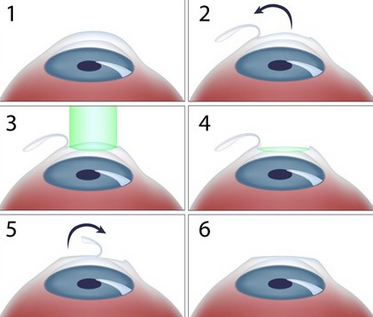Lasik
Lasik (for Laser Assisted in Situ Keratomileusis), is one of the reference techniques for the laser correction of myopia, astigmatism, hyperopia and presbyopia.
As with PRK, Lasik modifies the curvature of the cornea in order to eliminate the optical defects of the eye and refocus the light rays entering the eye on the retina.
Unlike PRK, LASIK involves an initial step.
A corneal flap (bonnet) is made using a femtosecond laser (“femtolasik” or “intralasik”).
Mechanical cutting with a microkeratome, which is less expensive but less reliable and less precise, has tended to disappear since 2004.
After lifting the bonnet, the Excimer laser corrects the depth of the residual cornea, then at the end of the operation the bonnet is repositioned. The creation of this cap avoids the postoperative discomfort associated with PRK, speeds up the visual recovery process and also allows a wider range of optical defects to be treated than with PRK.
Two lasers are used: a femtosecond laser to create the cap, and a second excimer laser to make the optical correction. The procedure takes an average of 10 to 15 minutes per eye, under local anaesthetic, and is usually painless.
The overall procedure for the Lasik procedure is as follows:
- Surface anaesthesia with an eye drop. The patient lies down, conscious, but without sensation.
- A suction ring is placed on the eye. The pressure exerted is sensitive but not painful, comparable to the pressure exerted by a blood pressure cuff. The Ziemer Z8 LDV femtosecond laser is lowered and the applanation lens is brought into contact with the eye. It is perfectly normal to lose light perception at this point. The laser action is painless and lasts 16 seconds, allowing the corneal flap to be prepared in a perfectly reliable and reproducible way.
- The corneal flap thus detached from the surface of the cornea (but still connected with a hinge) is about one tenth of a millimetre thick and 9 millimetres in diameter. It looks like a soft contact lens that remains connected to the cornea by a “hinge” like a car bonnet. The flap is lifted.
- The excimer laser placed at a distance from the eye performs the optical correction on the residual cornea in depth, modifies the corneal curvature by polishing a thickness of the cornea of a few microns during 3 to 4 seconds.
This polishing is done in the centre to correct myopia, or in the periphery to correct hyperopia and/or presbyopia. To correct astigmatism, the laser polishes more along the axis of the astigmatism. - The flap is repositioned and adheres firmly within a few minutes. No sutures are needed
The central cornea has become flatter for nearsightedness (or more curved for farsightedness or presbyopia) than before the procedure.

Indications for Lasik
Lasik is indicated for myopia up to -10 D, hyperopia from +1 to +5 D and astigmatism from 1 to 6 D. However, the exceptional risk of long-term corneal deformation (ectasia) justifies reserving this method for patients whose cornea has no identifiable risk factor (corneal thickness > 500 um, regular topography and aberrometry, stability of corneal shape, absence of keratoconus).
The Benefits of Lasik
- Comfort: No or little post-operative discomfort. Recovery in a few hours instead of 3 – 4 days for PRK.
- Efficiency and stability: the precision of Lasik treatment has been demonstrated since 1994 on more than 30 million eyes operated on worldwide. The result of the operation is stable.
- Safety: complications have become exceptional (see below) and are in the vast majority of cases managed very effectively.
The disadvantages of Lasik
- Technicality: the preparation of the flap is a more technical surgical act than for PRK, and therefore requires an experienced surgeon.
- Risk of aggravation of latent keratoconus: Lasik probably involves a risk of accelerating the evolution of pre-existing latent keratoconus (corneal ectasia). This is a progressive deformation of the cornea of genetic origin, favoured by the friction of the eye, which currently concerns 1 case in 10,000 Lasik operations. This risk is detected during the preoperative assessment and patients with a doubtful cornea (thin or irregular) cannot benefit from Lasik.
Cost: The fee for Lasik is higher than for PRK because the cost of using the femtosecond laser is added to that of the excimer laser used alone for PRK.

Laser Eye Surgery procedures are performed at Focus Eye Clinic in Brussels by Dr Qin
Financing your intervention
CONTACT
You want to make an appointment? You can either call one of the 5 sites via the button below, or make an appointment directly online in the Contact section, or send me a message in the Contact section
The ophthalmology secretaries and Dr. Qin’s team are available to answer all your questions and requests for information in order to make the best choice. I will be pleased to welcome you at one of the 5 sites.
Discover the 5 sites

